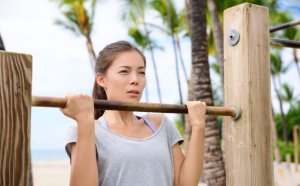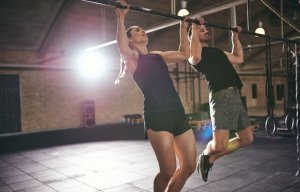What are Pull-Ups, and How to Perform Them Correctly

Pull-ups are, without a doubt, one of the most functional exercises that you can do. This move involves a number of muscles and joints of the upper body.
This body-weight exercise consists of flexing your muscles, in order to lift your body above a bar, while pushing with your body. In fact, pull-ups are typically used in most forms of military training. Due to the intense nature of the exercise, it’s incredibly beneficial to your body.
Unfortunately, many people become desperate when they try to lift their bodies and realize that they can only lift themselves a few centimeters from the ground. If you’re unable to get your body above the height of the bar, do not despair! It’s important to keep in mind that the heavier you are, the more difficult this move will be.
Four steps to a perfect pull-up
Firstly, stand underneath the bar and grab hold of it with both hands. Your palms should be facing inwards, and towards you, in line with your shoulders. If you can’t reach the bar, stand on a bench, stool, or a box. Then, wrap your thumbs around the bar so that they almost touch the fingertips of that hand.

Once you’re hanging from the bar, your arms should be totally extended, with your shoulders back. Don’t forget to lift your feet from the ground, and bend your knees. The best way to develop strength is by focusing on what your body is doing, which will help you to avoid going on autopilot, and just using your muscles. You want your whole body to be engaged with the exercise.
Secondly, initiate the actual pull-up by gripping the bar and connecting your upper-body muscles. Try to bring your elbows down to your sides, while squeezing your whole body. The goal is to easily clear the bar with your chin – that’s the ascending phase of a pull-up.
Lastly, once your chin is above the bar, it’s time to slowly let yourself down. Take advantage of this part to recuperate your energy. You have to remember that the ultimate goal is to get your chin above the bar again, and in the next repetition. The objective, of course, is to try to complete the highest possible number of repetitions that your body can handle.
“Excellence is not a singular act, but a habit. You are what you repeatedly do.” – Shaquille O’Neal
What are common pull-up errors?
Here are the most frequent errors that arise when beginners try to do pull-ups. Take note of these and correct them if you’re doing them – otherwise you might hurt yourself!
Elbow placement
One frequent mistake is to keep the elbows too close and facing forwards. This makes the biceps work harder than they should. This is more a tip than a correction, but like any traction exercise you perform for your back, you should always focus on keeping the resistance in your elbows, as opposed to using your hands or arms.

Shoulder placement
Just like with the elbows, you should keep your shoulders pulled back, in order to work the right muscles. In addition, keep adjusting your shoulders as you perform each pull-up, to find the right position. Otherwise you could be putting undue pressure on your joints, tendons, and muscles.
Not completing the full range of movement
A complete range of motion starts at zero exertion and continues until the chin rests lightly on top of the bar. If you’ve incorporated pull-ups into your training routine, it’s essential to achieve full extension and the complete range of motion. Keep this is mind if you want to reap the benefits of this difficult move.
What are the benefits of pull-ups?
Pull-ups are certainly one of the best body-weight exercises around. Here are the benefits:
- Improving your grip strength
- Minimal equipment requirement
- Build up strength for other exercises that work your upper body
- Numerous variations of the exercise can be used, adjusting it for desired intensity level
- It repeatedly works the muscles and parts of the body that you need for daily activities
- Tones the upper body, though it specifically targets the back, arms, and abdominal muscles.
- While strengthening your back, you can achieve a better posture.
Lastly, once you master the exercise, remember that there are different ways to customize pull-ups in order to work different muscles. For example, you can move your hands closer together or further apart on the bar. You can even try flexing upwards, with your palms facing in a different direction, to place more emphasis on building your biceps.
Pull-ups are, without a doubt, one of the most functional exercises that you can do. This move involves a number of muscles and joints of the upper body.
This body-weight exercise consists of flexing your muscles, in order to lift your body above a bar, while pushing with your body. In fact, pull-ups are typically used in most forms of military training. Due to the intense nature of the exercise, it’s incredibly beneficial to your body.
Unfortunately, many people become desperate when they try to lift their bodies and realize that they can only lift themselves a few centimeters from the ground. If you’re unable to get your body above the height of the bar, do not despair! It’s important to keep in mind that the heavier you are, the more difficult this move will be.
Four steps to a perfect pull-up
Firstly, stand underneath the bar and grab hold of it with both hands. Your palms should be facing inwards, and towards you, in line with your shoulders. If you can’t reach the bar, stand on a bench, stool, or a box. Then, wrap your thumbs around the bar so that they almost touch the fingertips of that hand.

Once you’re hanging from the bar, your arms should be totally extended, with your shoulders back. Don’t forget to lift your feet from the ground, and bend your knees. The best way to develop strength is by focusing on what your body is doing, which will help you to avoid going on autopilot, and just using your muscles. You want your whole body to be engaged with the exercise.
Secondly, initiate the actual pull-up by gripping the bar and connecting your upper-body muscles. Try to bring your elbows down to your sides, while squeezing your whole body. The goal is to easily clear the bar with your chin – that’s the ascending phase of a pull-up.
Lastly, once your chin is above the bar, it’s time to slowly let yourself down. Take advantage of this part to recuperate your energy. You have to remember that the ultimate goal is to get your chin above the bar again, and in the next repetition. The objective, of course, is to try to complete the highest possible number of repetitions that your body can handle.
“Excellence is not a singular act, but a habit. You are what you repeatedly do.” – Shaquille O’Neal
What are common pull-up errors?
Here are the most frequent errors that arise when beginners try to do pull-ups. Take note of these and correct them if you’re doing them – otherwise you might hurt yourself!
Elbow placement
One frequent mistake is to keep the elbows too close and facing forwards. This makes the biceps work harder than they should. This is more a tip than a correction, but like any traction exercise you perform for your back, you should always focus on keeping the resistance in your elbows, as opposed to using your hands or arms.

Shoulder placement
Just like with the elbows, you should keep your shoulders pulled back, in order to work the right muscles. In addition, keep adjusting your shoulders as you perform each pull-up, to find the right position. Otherwise you could be putting undue pressure on your joints, tendons, and muscles.
Not completing the full range of movement
A complete range of motion starts at zero exertion and continues until the chin rests lightly on top of the bar. If you’ve incorporated pull-ups into your training routine, it’s essential to achieve full extension and the complete range of motion. Keep this is mind if you want to reap the benefits of this difficult move.
What are the benefits of pull-ups?
Pull-ups are certainly one of the best body-weight exercises around. Here are the benefits:
- Improving your grip strength
- Minimal equipment requirement
- Build up strength for other exercises that work your upper body
- Numerous variations of the exercise can be used, adjusting it for desired intensity level
- It repeatedly works the muscles and parts of the body that you need for daily activities
- Tones the upper body, though it specifically targets the back, arms, and abdominal muscles.
- While strengthening your back, you can achieve a better posture.
Lastly, once you master the exercise, remember that there are different ways to customize pull-ups in order to work different muscles. For example, you can move your hands closer together or further apart on the bar. You can even try flexing upwards, with your palms facing in a different direction, to place more emphasis on building your biceps.
This text is provided for informational purposes only and does not replace consultation with a professional. If in doubt, consult your specialist.








